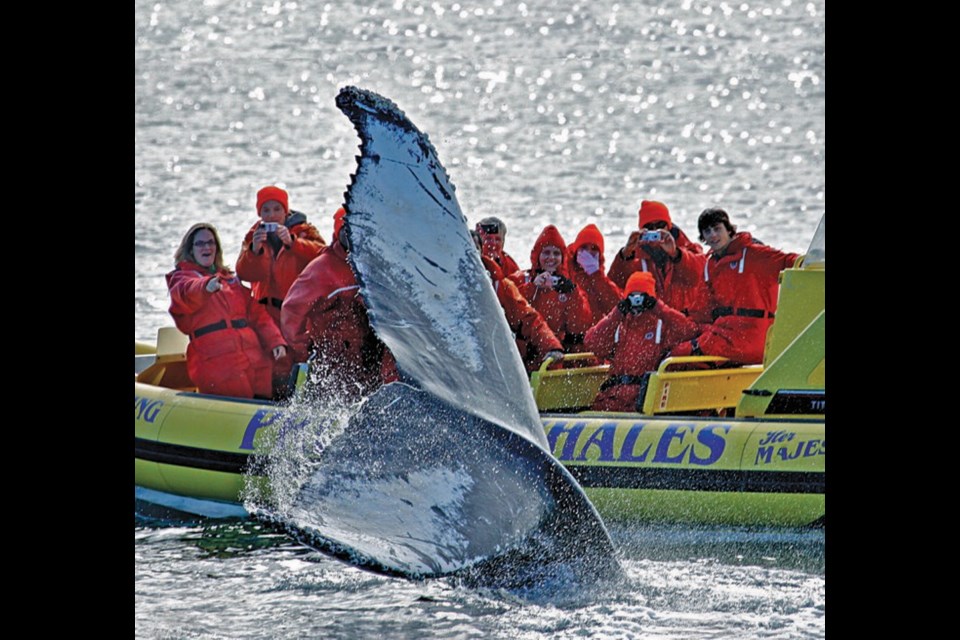A recent collision between a Victoria whale-watching vessel and a humpback near Race Rocks was “anything but a freak accident,” says researcher Jackie Hildering.
Hildering, a director of the Port McNeill Marine Education and Research Society, isn’t being judgmental or critical. The comeback of humpbacks has been so remarkable on the West Coast that they catch even professionals by surprise.
Last summer, the Pacific Whale Watch Association, which represents whale-watching companies in sa���ʴ�ý and Washington state, reported that humpbacks have made a major comeback. An estimated 21,000 whales are in Pacific Northwest waters, compared with just 1,600 when the whaling industry, which included Vancouver Island, closed in the mid-1960s.
Their behaviour is different from the orca behaviours boaters are accustomed to — which contributes to the problem.
A Zodiac vessel operated by the Prince of Whales company struck a humpback near Race Rocks on Aug. 7. Two people were taken to hospital with injuries.
“The very fact that a whale-watch captain, who knows the behaviour of the whales, can have such an unfortunate accident proves how very real the risk of collision is to boaters i.e., this is anything but a freak accident,” Hildering said in an email to the sa���ʴ�ý.
As for ordinary boaters, she said, they are “not aware that the humpbacks are back.” The lack of awareness can lead to interactions that are dangerous for both humans and humpbacks, which can be “astoundingly oblivious of boats, especially when they are feeding.”
Vilifying boaters or whale-watchers for striking or almost striking humpbacks is “not part of the solution” to minimizing the risk of such incidents, she said.
Hildering does not believe that humpback strikes are isolated incidents. She’s concerned that boaters who feel guilty about making contact or nearly hitting humpbacks are reluctant to report what has happened, which reinforces the incorrect idea that such occurrences are rare.
That kind of misunderstanding can lead to dangerous outcomes for both humans and humpbacks, she said. She wants to encourage anyone in a vessel to report any incidents so that the humpback involved can be identified and the nature of their injury recorded.
The non-profit society has been part of a federally funded campaign to increase boater awareness of whales for years, she said. She asks that boaters report any incidents to 1-800-465-4336, the Department of Fisheries and Oceans Incident Reporting Line.
“The risk is very real to both the whales and boaters,” she said, citing three more known humpback strikes this summer, off Kitimat on July 2, in Haida Gwaii at the end of June, in which three people were injured and one of them airlifted to hospital and in July off Campbell River, leading to a shoulder injury for a boater.
In the same way that an elk can jump onto a highway, humpbacks can emerge suddenly from the depths, she said. On June 25, the Haida Gwaii Observer reported that two men were airlifted to hospital with serious injuries when a guided fishing boat hit a humpback just outside Naden Harbour.
“It did not breach — it surfaced to take air, a couple of inches showing above the water,” said Sgt. Steve Vince of the Masset RCMP.
Responders saw what appeared to be whale tissue lodged on the hull of the boat, which had been travelling at about 20 knots.
��
On July 2, a humpback collided with a boat on Bishop Bay near Kitimat. According to MERS, one of the occupants contacted the report line to say: “We were on the lookout and did not see any signs of whales being present. The humpback surfaced out of nowhere right in front of the boat. We could not get out of the way of the whale. The boat slammed the whale and became airborne and we were thrown around the boat. It was terrifying. We want [the collision] to count so that others are more aware of the risk.”
“Simply put, the return of humpbacks from the brink of extinction is a game changer for boaters,” Hildering said and the society is trying to get the word out through presentations, coast-wide signage reading “see a blow go slow” and the media.
There are about 50 signs already posted that illustrate the potential impact between humpbacks and boaters placed on the West Coast.
“They are up in many locations in Victoria. And we are always looking for more sponsors for them,” she said.
The presence of a lot of birds is a sign that whales might be underwater, seeking the same kind of food, krill and herring that baleen whales such as humpbacks eat. Humpback blows can be two metres high, but are hard to see in windy conditions.
Among the differences she cites: Humpbacks do not have bio-sonor as do toothed whales, such as orcas. They do not travel in one direction, are not as easy to see because they spend less time on the surface of the water and just because they dive deep doesn’t mean they’ve gone away. Humpback generally dive for five to eight minutes, but can stay down as long as 20 minutes. “It’s most often impossible to predict where they will surface as they’re travelling in random patterns as they look for food.” in contrast, orcas spend more time on the surface and travel in a predictable direction.
Humpbacks are “extremely unpredictable” and also very acrobatic and prone to random moves especially when they feed. “Sometimes, they’re socializing and they can end up approaching boats,” she said. That would likely prompt boaters to start their engines, “potentially chopping up the whales.”
Anyone who sights a humpback should not approach within 100 metres.
“If a whale surfaces within 100 metres of your vessel, place engine in neutral (or, ideally, shut off the engine) until the whales are beyond 100 metres,” the MERS website states. “Slow down. Speed should not be more than seven knots when 100 to 400��metres from a whale.”
To sponsor a sign (for about $70), contact [email protected].



